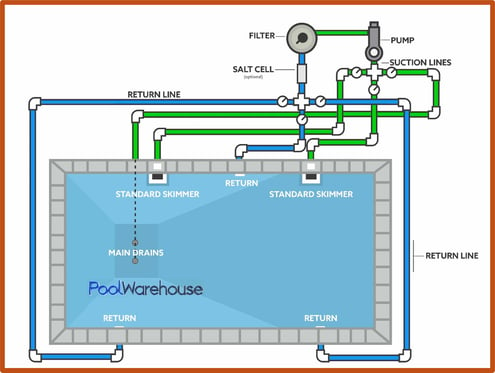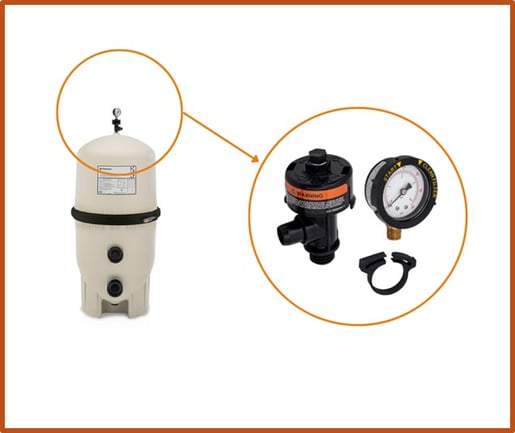Last week we saw a brief overview of a pool system and explored the heart of the system—the pump. Today we are going to dive into filters.
As a quick refresher, here is the image from Pool Warehouse that shows where the filter is in relation to the rest of the pool system: skimmer, pump, filter, heater, sanitizer, pool body, repeat.

And in this photo taken at one of Denscot’s pools, you can see that although the heater is physically between the pump and the sand filter, the PVC lines bypass the heater on the visible side, taking water directly from the pump to the sand filter. Once the water comes back out of the filter, more PVC lines on the other side will direct the water through the heater.
.png?width=480&height=506&name=Untitled%20design%20(4).png)
The practice of filtering water is not new. People started boiling and filtering their drinking water sometime between the 4th and 5th centuries. Then, a man named Hippocrates developed a way to pass water through a cloth, removing silt and other debris. By the early 1800’s, public city filtration plants were growing in both necessity and popularity. Water filtration and sanitization was growing and advancing quickly to keep up with the demands of a growing global population. Pool water filtration, however, was another story. For years the primary method of “filtration” for pools was to completely drain the pool, then clean out whatever silt, debris, and whatnot, had settled on the floor and walls, often scooping unwanted waste out with shovels and buckets. It wasn’t until about 1910 that modern pool filtration really came around.
In the modern pool industry, there are two classifications of filter system, pressure, and vacuum. Pressure systems are what you see pictured above—the pump is pushing (with great pressure) all the water through the filter. Vacuum systems are uncommon in residential pools. We tend to see them more in public and commercial pools. The filter is plumbed before the pump, so that the pump is sucking, or vacuuming, the water out of the pool through the filter.

There are three primary types of filters that pool owners can choose from: Cartridge Filters, DE Filters, and Sand Filters. These names identify the medium used to filter your water. All filters have a pressure gauge and air relief valve located at the top of the filter tank. While this feature is particularly adorable, and one of my favorite parts to work with, it serves an important purpose. During a filter cycle, air will build up in your filter tank. This gauge will tell you your pressure reading, and the air relief valve will release that pressure before you open the tank. Remember, before you loosen any clamps or begin opening the filter tank for service and cleaning, turn off the pump and open the air relief valve first. Loosening clamps and belts without releasing the air pressure can be very dangerous.
Next entry we will explore further the three different kinds of filters, how they function, and how you can choose the right filter for your pool.